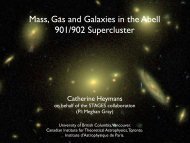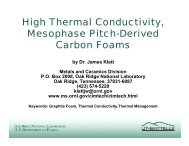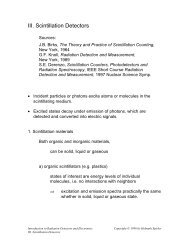Introduction to radiation-resistant semiconductor devices and circuits
Introduction to radiation-resistant semiconductor devices and circuits
Introduction to radiation-resistant semiconductor devices and circuits
You also want an ePaper? Increase the reach of your titles
YUMPU automatically turns print PDFs into web optimized ePapers that Google loves.
performance advantages. For these reasons, despite the fascinating physics of<br />
compound semiconduc<strong>to</strong>rs, this tu<strong>to</strong>rial will emphasize silicon technology.<br />
The study of <strong>radiation</strong> effects in semiconduc<strong>to</strong>r electronics <strong>and</strong> the development<br />
of <strong>radiation</strong>-<strong>resistant</strong> integrated <strong>circuits</strong> have formed an active scientific<br />
community that has produced a wealth of data <strong>and</strong> conceptual underst<strong>and</strong>ing.<br />
Although access <strong>to</strong> some of these results <strong>and</strong> techniques is restricted, most of the<br />
data <strong>and</strong> papers are in the public domain <strong>and</strong> readily accessible, <strong>and</strong> they provide a<br />
valuable resource (see the Bibliography at the end of this paper). Although, much<br />
has been published on basic damage mechanisms <strong>and</strong> on device properties for<br />
specific applications, when attempting <strong>to</strong> apply this information <strong>to</strong> an area outside<br />
the traditional purview of the <strong>radiation</strong> effects community, key pieces of<br />
information needed <strong>to</strong> link basic damage mechanisms <strong>to</strong> usable design guidelines<br />
are often missing. This was very clear in the development of detec<strong>to</strong>rs for the SSC<br />
<strong>and</strong> LHC, where both the application of detec<strong>to</strong>rs with deep depletion regions <strong>and</strong><br />
novel circuit designs combining low-noise, high-speed <strong>and</strong> low power pushed<br />
developments in<strong>to</strong> uncharted terri<strong>to</strong>ry.<br />
This is a very complicated field <strong>and</strong> developing a general road map is not easy,<br />
but one can apply a few fundamental considerations <strong>to</strong> underst<strong>and</strong>ing the effects of<br />
<strong>radiation</strong> on device types in specific circuit <strong>to</strong>pologies <strong>and</strong> narrow the range of<br />
options that must be studied in detail. That is the thrust of this tu<strong>to</strong>rial. For lack of<br />
time, some treatments are sketchier than desirable <strong>and</strong> the reader should consult<br />
the references <strong>and</strong> the bibliography. This paper originated as a tu<strong>to</strong>rial talk at the<br />
1996 Beam Instrumentation Workshop at Argonne National Labora<strong>to</strong>ry in May,<br />
1996 <strong>and</strong> will be exp<strong>and</strong>ed <strong>and</strong> modified in response <strong>to</strong> criticisms <strong>and</strong> new<br />
developments. (1)<br />
RADIATION DAMAGE MECHANISMS<br />
Semiconduc<strong>to</strong>r <strong>devices</strong> are affected by two basic <strong>radiation</strong> damage<br />
mechanisms:<br />
• Displacement damage: Incident <strong>radiation</strong> displaces silicon a<strong>to</strong>ms from their<br />
lattice sites. The resulting defects alter the electronic characteristics of the<br />
crystal.<br />
• Ionization damage: Energy absorbed by electronic ionization in insulating<br />
layers, predominantly SiO2, liberates charge carriers, which diffuse or drift <strong>to</strong><br />
other locations where they are trapped, leading <strong>to</strong> unintended concentrations of<br />
charge <strong>and</strong>, as a consequence, parasitic fields.<br />
2





